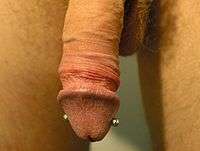Ampallang
| Ampallang | |
|---|---|
 | |
| Location | Glans |
| Jewelry | Straight barbell |
| Healing | 5 months |
The palang (crossbar in Iban), better known in the West as ampallang in the term popularised by Doug Malloy, is a male genital piercing that penetrates horizontally through the entire glans of the penis.[1] The piercing may be transurethral (passing through the urethra) and named as the European ampallang, whereas the American ampallang is placed horizontally above the urethra, generally back toward the corona.[2] A variant on this piercing is the shaft ampallang, which penetrates the shaft of the penis horizontally at any point along its length. The counterpart to this piercing is the apadravya, which penetrates the glans vertically. The combination of an ampallang and an apadravya is sometimes referred to as the magic cross.
This piercing, once healed, is often pleasurable to the bearer because it stimulates the internal penis tissues.[3] On the other hand, anecdotal evidence suggests that, as opposed to apadravya, ampallang is not a piercing of choice for vaginal intercourse but may be the best functional piercing for anal sex.[4]
Health issues
Ampallang is an advanced piercing, and the procedure can be extremely painful. Full healing usually takes between four and six months, but can take a year or more.
The primary health issues related to this piercing are during the procedure itself and during the healing process. Depending on the placement, there can be a significant amount of blood loss, both during the procedure and during the initial healing process. The measurement for the piercing jewelry is typically done by the receiver in private on his erect penis, while the actual piercing is done on his flaccid penis. The long healing process requires that the bearer abstain from sexual intercourse for a lengthy period of time, on the order of six weeks to six months.
It is possible for this piercing to injure or damage the teeth and soft palate of the giving party during oral sex.
If this piercing is transurethral, it can divert the flow of urine, forcing the bearer to sit down or take other measures during urination. The piercing will leave a tube of scar tissue, which will remain even if the jewelry is removed and the piercing allowed to heal.
Jewelry
Straight barbells are almost exclusively worn in ampallangs, both initially and after they are healed. Jewelry must be long enough to accommodate the expansion of the penis during erection, at the risk of extreme discomfort for the wearer. After initial healing the piercing can be stretched and larger jewelry can be inserted, reaching sizes above 10 mm in diameter.
History and culture

This piercing predated European contact with tribes in (among others) the Philippines[5] and Borneo (Dayak people). In some cultures, having an ampallang may be seen as a pre-requisite for marriage. Thomas Cavendish claims that in the Philippines the practice was an invention of the women to prevent sodomy (the Philippines variant included a spur).[6]
In contemporary society, it became popularized along with the many genital piercings practiced amongst the gay BDSM community prior to the establishment of the body piercing industry in the 1980s and 1990s. Due to its legitimate primitive origins, this piercing is closely associated with the modern primitive movement.
According to urban legend, should this piercing penetrate the corpus cavernosum penis, the recipient could bleed to death. This is not true, although should the piercing penetrate the corpus cavernosum, it may bleed more heavily, both initially and during the healing process, than it normally would.
References
- ↑ John Baxter (10 February 2009). Carnal Knowledge: Baxter's Concise Encyclopedia of Modern Sex. HarperCollins. p. 10. ISBN 978-0-06-087434-6. Retrieved 24 December 2011.
- ↑ Male Genital Piercings - Piercing Bible
- ↑ UCSB SexInfoOnline - Body Piercing
- ↑ Ampallang vs Apadravya
- ↑ Antonio Pigafetta; Theodore J. Cachey (October 1995), The first voyage around the world (1519-1522): an account of Magellan's expedition, Marsilio Publishers, pp. 57–8, ISBN 978-1-56886-005-3, retrieved 9 July 2010
- ↑ for Cavendish: ibid, pg. 158. For spur: ibid, pg. 58.